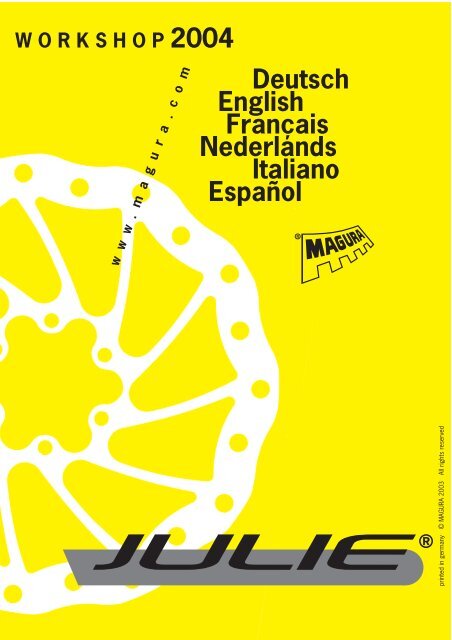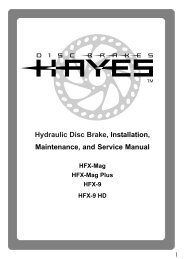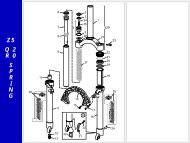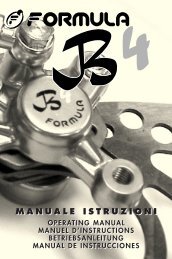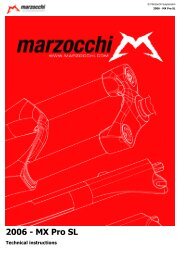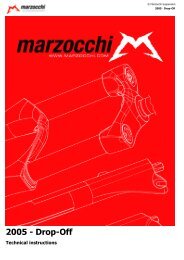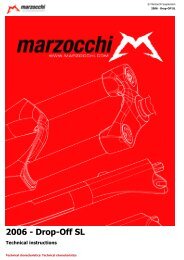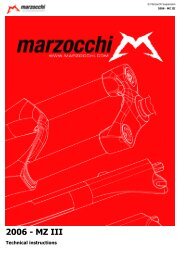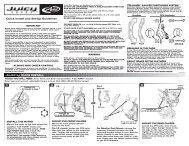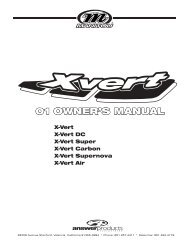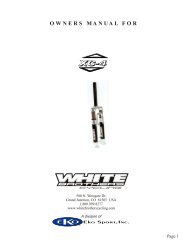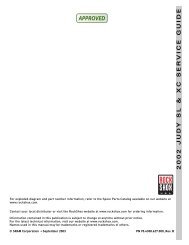Deutsch English Français Nederlands Italiano Español - Birota
Deutsch English Français Nederlands Italiano Español - Birota
Deutsch English Français Nederlands Italiano Español - Birota
Create successful ePaper yourself
Turn your PDF publications into a flip-book with our unique Google optimized e-Paper software.
WORKSHOP2004w w w . m a g u r a . c o m<strong>Deutsch</strong><strong>English</strong>Français<strong>Nederlands</strong><strong>Italiano</strong>Españolprinted in germany © MAGURA 2003 All rights reserved
www.magura.comservice@magura.deTable of Contents1. Introduction 32. Safety instructions before the first ride 43. Safety instructions before every ride 4-54. Transport of the bicycle 55. Brake installation 6-96. Shortening the hose 10-117. Maintenance 12-138. Repairs 14-159. Bleeding and Filling 15-1710. Trouble Shooting 1711. The disc brake wheel 1812. Accessories 19-2013. Warranty 2014. Spare parts exploded view 21WARNING:This symbol means possible danger for your health and even life if you do not followthe instructions given respectively if the necessary safety measures are not followed.ATTENTION:This symbol warns you of inappropriate handling that might cause serious damage tothe material and/or the environment.NOTE:This symbol gives you additional information about the general handling of theproduct or gives hints to paragraphs in this manual which have to be read carefully.2
www.magura.comservice@magura.de1. Welcome to the Brake People!Brake lever (master cylinder)MAGURA JulieOn the fully hydraulic MAGURA disc brake system Julie the braking force is transmittedto the braking surface by a mineral oil column. The movement of the lever blademoves a piston, which is integrated in the brake lever (master cylinder). The piston pushesthe mineral oil column through the brake hose in the direction of the brake caliper,where two pistons, on which the brake pads are fixed, are pushed out. The friction betweenthe brake pads and the rotor slows down the bicycle and causes both the rotorand the brake calliper to heat up.Never touch either the rotor or the brake caliper after long braking as thismay cause serious burns.You will be pleased to find out that the MAGURA Julie disc brakes offer a superiorbraking power even with little hand force applied, no matter what the weather conditionsshould be. Particularly in wet weather conditions disc brakes are much more responsivethan rim brakes and transmit their enormous power immediately after activating thebrake lever.Disc brakes dont’t wear your rims down. However, if they have been mounted incorrectly,they might cause a squealing noise during braking, mainly during wet weather conditions.This manual contains important information about the safe installation,operation and maintenance of your MAGURA disc brake. We urge you to readit carefully, become familiar with its contents and follow our recommendationsto help make your new braking experience enjoyable and trouble free.Although the Julie disc brake system is relatively simple you should notoverestimate your technical skills! We therefore advise you to leave the followingoperations to a trained technician of a professional bike shop.Should there be any further questions or problems we warmly recommend that youvisit our website www.magura.com where you will always find the newest and hottesttips about all our products. Stay tuned with the Brake People!Thank you for your confidence in our products, enjoy your ride and yournew MAGURA disc stoppers!Happy trails!Congratulations! You have purchased afully hydraulic MAGURA disc brake proudly„Made in Germany“. You will be amazedat the awesome braking power and theminimum amount of maintenance that isnecessary on our stoppers. Good toknow that you are not alone, millions ofriders worldwide rely on them and everyday our numbers are increasing.Brake caliper and rotorMAGURA JulieEspañol <strong>Italiano</strong> <strong>Nederlands</strong> Français <strong>English</strong> <strong>Deutsch</strong>3
www.magura.comservice@magura.de2. Before the first ride1. Are you already familiar with hydraulic disc brakes? Our brakes might be muchmore powerful than the stoppers on which you relied on so far.Take your bicycle to a safe area to learn the proper braking technique and operation ofyour new brakes and your bike.2. Check that the fornt brake is still actuated by the lever on the side yourare used to braking with. Should this not be the case you wll have to train toyour new setup, otherwise any unintended front wheel braking manoeuvre maycause an accident leading to possible serious injury! If in doubt get a trainedtechnician to swap the hoses. For further hints concerning swapping of thebrake hose see page 10 onwards.3. New brakes and new rotors or brake pads must always be run in bybraking at least 30 times from a speed of 30km/h to achieve the maximumbrake power. Take your bike to a safe place to run in the brake.4. While riding in extreme riding conditions (total weight of bike plus riderover 100kg and/or a gradient of more than 15%) always use both brakessimultaneously to slow your bike down.5. Do not use the Julie disc brake for downhill sport or on tandems! Any misusemight cause serious accidents with fatal injuries to yourself and others!6. Are you familiar with the other components on your bike such as gears, cliplesspedals and suspension units? Always practise using your bike in a safe area to improveyour handling abilities before using it on the road. Consult the user’s manual of your biketo learn more about this.7. For your own safety always wear a helmet when you ride a bicycle. Make sure aswell that you wear suitable clothing and footwear.3. Before every rideAlways check carefully the following points:1. Always make sure that the quick release skewers of your wheels and seat postare correctly mounted and closed.incorrectly installed quick release skewers might cause the fixed items tobecome loose. Serious accidents with severe injury may result!!2. Always make sure that the brake lever pressure is o.k. by pulling the lever bladeand ensuring that full braking performance is achieved before the lever blade touchesthe handlebars. If this is not the case, pull the lever blade several times (pump) until thebrake pads touch the rotor.Changing pressure points during a ride might be the result of having air in the brakesystem.See hints about filling and bleeding from on pages 15/16.4
www.magura.comservice@magura.de3. Always make sure that the brake system does not have any leaks by activatingthe lever blade, holding it and checking the hose connections and reservoir cover foreventual leaks. (Also see page 11)4. Always protect your rotors and brake pads from oil and lubricants (e.g. by lubricatingyour chain). Avoid detergents and soap on the brake pads. Contaminating thepads with oil and lubricants will cause a permanent loss of braking power. Such contaminatedpads can no longer be used and should be replaced! Clean a contaminated rotorwith dishwater or alcool. See further hints about changing the brake pads on pages 11-13.5. Release your brake lever and check whether your wheel moves freely and withoutdrag. Check eventually whether the wheels are correctly mounted and if the quick releaseskewers are tightened sufficiently. (Also see page 9)6. Are your tires in a good condition, and have they enough air pressure? Test thiswith your fingers. Lift up your bike and turn the wheels of your bike. An insufficient rotationmight be due to damaged tires, broken axles and/or broken spokes.7. Pick up your bike and let it drop from a moderate height. Listen for any rattlingnoises. If any are heard check the bearings and all screwed connections.8. Always follow the instructions given in the owner’s manual of your bicycle.Never use your bicycle if any of the points mentioned above relate to yourbicycle! Consult a professional bike mechanic if you feel unsure. A faulty bicyclemay result in serious accidents with possible fatal injuries of the rider! Becareful to check always to check the following points:4. Transport of the bicycleIn case of a disc brake equipped bicycle you should always keep in mindthe following points:Never activate the lever blade without the brake pads in place and the wheelsmounted. In case this should have happened see page 10 of this manual.Never throw away the transport device, which has been delivered with the brake.Always clip it between the brake pads whenever the wheel is removed (e.g. transportof the bike).Always carefully removed wheels. Make sure that the rotors are not damaged,deformed or contaminated with lubricants.If the bike is transported upside-down squeeze (with mounted wheel ortransport device!) the lever blade before, hold pressure and fix the blade in thisposition with a rubber band or a cable tie.During transport in an aircraft you can leave your brake as it is, e.g. you do nothave to empty it.Español <strong>Italiano</strong> <strong>Nederlands</strong> Français <strong>English</strong> <strong>Deutsch</strong>5
www.magura.comservice@magura.de5. Brake Installation1. Tools for installation (+maintenance)Allen key 2*, (3) and 5transport/mounting device*sharp knife8mm open end wrenchflat blade screw driverTorx T25 key*(Torx T7 key)(*delivered with the brake)Always insert the allen and torx keys completely to avoid damagingthe bolt heads.1231186957104Unpack your Julie disc brake:1. brake lever (master cylinder) connected through the2. brake hose with the3. brake caliper with transport device (IS/Postmount with quickmount adaptor)ATTENTION: remove4. YELLOW transport device only shortly before installation of the wheel!)5. rotor (diameter front 180mm, rear 160mm)6. fitting bolts for caliper Allen key 5 (2 pieces)7. fitting bolts for rotor Torx key T25 (6 pieces)8. black 1mm spacers (2 pieces, only necessary for rear brakes)9. olives (2 pieces)10. Torx T25 key11. Allen key 2mmnot shown: hose fitting kit for rear brake (comes with all rear brakes)specifications modifying and improving this product are subject tochange without prior notice.6
www.magura.comservice@magura.deThe brake levers, calipers and hoses of the different MAGURA disc brakemodels are completely different and not compatible! Never mix and matchparts from the two models. Any misuse might cause serious accidents!MAGURA manufacture these braking systems according to the valid standards andmake many rigorous product tests. Because of the large variety of forks and framesavailable on the market it is impossible for MAGURA to test all possible combinations. Ifyou mount any of our brake systems always make sure that the brakes are in conformitywith the bicycle.Disc brake calipers can generate a lot of heat during extreme riding conditions.The resulting heat transfer from the caliper to the fork and/or frame canhave a negative influence on the mechanical characteristics of both the forkand/or the frame.Insufficient heat transfer from the brake caliper to the frame and the fork,caused by fork and or frame components having low heat transfer characteristics(e.g. carbon rear triangles) can cause the brake to overheat, with the possibilityof a total failure of the brake system. This can cause serious personalinjury to yourself and/or others.With respect to product liability we remind all our users that any manufacturer(also: bike mechanic or end consumer!) is responsible for the correctfunction of the complete bicycle in this context. Improper combinations andinsufficient installation can cause damage and serious accidents!2. Mount the brake lever to the handlebar with a 5mm allen key. If you install yourbrake lever the first time you’ll hear a crack, do not worry because of that. Tighteningtorque 4Nm/34 in.lbsThe MAGURA Julie disc brake is compatible with frames and forks whichmeet the international standard (IS) for disc brake installation. By dismountingthe Quickmount adaptor, the front brake is also compatible with Manitou forkswith Postmount mounts. Never mount the brakes with adapters or bracketsfrom other manufacturers! All warranty will be void in case of any misuse! Useonly direct mounting parts from MAGURA or the frame or fork’s manufacturer!Make sure that the caliper fitting eyelets on your frame or fork are free of any paint,powder coating or burrs. (arrows). If this is not the case you should contact your dealerwho will be able to clean the surfaces, providing an absolutely flat/even mounting surface(also see page 9).ATTENTION: The treatment of suspension lower legs made of magnesiummight be dangerous because of corrosion! Always follow the safety instructionsgiven by the respective manufacturer! Always make sure after having treatedthe disc brake mounts that these are protected against corrosion by using anappropriate protective paint.Español <strong>Italiano</strong> <strong>Nederlands</strong> Français <strong>English</strong> <strong>Deutsch</strong>7
www.magura.comservice@magura.deAB3. Mounting on forks and frames that meet the International Standard:Mount the caliper onto the fork or the frame (bolts “A”). Use a 5mm allen key.Tightening torque: 6Nm/51 in.lbs. Do not tighten yet the bolts “B”4. Mount the rotor with the 6 Torx T25 bolts onto the hub. Watch out for the correctrotation direction of the rotor (laser arrow). Use only new original bolts or threadlock if you use old bolts. Tighten the bolts in a crossed pattern! Tightening torque:4Nm/34 in.lbs.5. Remove the transport device shortly before installing the wheel and mount thewheel.6. Squeeze now the brake lever, hold the pressure and tighten the fitting bolts “B”.Tightening torque: 6Nm/51 in.lbs.If you have a Manitou fork proceed exactly in the same way, but dismountthe quickmount adaptor beforehand.7. However you must use the black 1mm spacers between fitting eyelets and caliperon a Julie rear brake. If necessary you might have to use here as well additional0,2mm spacers for a clean and drag free positioning of the calliper because frames arevery often not well enough aligned.The transport device prevents the brake pads from being pushed out toofar by unintended lever squeeze. It is impossible then to install the wheel withthe rotor. So never throw away the transport device. Keep it and always clipit between the brake pads when the wheel is removed.8
www.magura.comservice@magura.deInstall the wheel by positioning the rotor between the brake pads and fixing thewheel in the dropouts. Close the quick release of your wheel which you should mounton the opposite side of the brake caliper and tighten it sufficiently. As to thru-axlehubs or wheels consult the manual of the respective fork manufacturer.Squeeze the lever blade several times (pump) to push the pads to their properposition until the lever feel becomes very firm.8. Correctly mounted disc brake wheel.The rotor has to run directly under the separation line of the caliper halves (seearrow). If ever this is not the case re-position the calliper with the 0,2mm spacers.O.K.! wrong! wrong!In the case of a constantly dragging disc brake causing noise your frame couldbe miss-aligned. In such a case you should contact your dealer who can care to this withthe MAGURA Gnann-o-mat disc optimizer for a totally even surface of the disc brakemounts. These are absolutely necessary for a drag free function of your brake.Do not worry when you hear friction between rotor and pads. A slight dragis normal on disc brakes with automatic pad wear adjustment during the breakinperiod. This drag will disappear after a while. The reason for this is that thebrake pads find their optimum working position towards the rotor, only after aslight wear during the break-in period. Slight drag might also happen after abrake pad change or in case of an incorrectly installed wheel.New brakes and/or new rotors or brake pads must always be run in bybreaking at least 30 times from a speed of 30km/h to achieve the maximumbrake power. Take your bike to a safe place to run in the brake.Reach adjust is done with a 2mm Allen key. Turning key clockwise: leverblade moves away from the handlebar, turning counterclockwise: blade moves to thehandlebar.Español <strong>Italiano</strong> <strong>Nederlands</strong> Français <strong>English</strong> <strong>Deutsch</strong>9
www.magura.comservice@magura.de6. Shorten the hoseThe Julie is a low-pressure system and comes with the same nylon hosethat is used on MAGURA rim brakes. Do NOT use the reinforced hose of theother disc brakes with “Disc Tube” imprint and do NOT mix and match itemsof different MAGURA disc brakes!” Any misuse might cause serious accidents!Never touch either the rotor or the brake calliper after long braking as thismay cause serious burns.1. Remove the wheel so that you have free access to the brake calliper.Push back both brake pads by putting the transport device or a flat blade screwdriverinto the gap. Move the screwdriver slowly back and forth until both calliper pistons arefully retracted and flush with calliper body.Never push back the pistons without the brake pads mounted! Open thebrake system only after having fully pushed back the brake pads.2. Loosen the brake lever clamping screw with a 5mm allen key. Turn the brakelever and ensure that the reservoir is horizontal. Squeeze slightly the lever blade andslide the 2mm allen key between brake lever and lever blade.3. Slide the hose protection. Unscrew the sleeve nut on the brake lever with an8mm open-end wrench and pull the hose out carefully. Hold the hose carefully toavoid any loss of oil! Do not squeeze the lever blade with the system open!4. Put the hose on a workbench and shorten it with a sharp knife. The best tool isthe MAGURA cutter (code 0321 233). Do not use saws or pliers!If your frame is not equipped for routing hydraulic lines you should now mount thehose fitting kit (available as separate accessory, see magura.com) for your rear brakeaccording to the instructions that are included in the kit.10
www.magura.comservice@magura.deHold the hose carefully so that it cannot snap away! Cut the hose squarely!The sleeve nut can be re-used. The olive cannot be re-used and must be replaced!5. Slide on the sleeve nut and a new olive onto the hose. Push the hose with thesleeve nut and the new olive fully into the brake lever and tighten the sleeve nut withan 8mm open-end wrench. Tightening torque: 4Nm/34 in.lbs.6. Always check for correct installation by pulling on the hose. Make surethat the system has no leaks. Squeeze the lever blade, hold pressure andcheck hose connections and the reservoir cover for eventual leaks.Squeeze the lever blade several times (pump) to push the pads to theirproper position until the lever feel becomes very firm. If you cannot realizethis, bleed the brake (see page 15 onwards).Español <strong>Italiano</strong> <strong>Nederlands</strong> Français <strong>English</strong> <strong>Deutsch</strong>11
www.magura.comservice@magura.de7. MaintenanceBrake Oil: MAGURA disc brakes use a transmission medium low viscosity mineraloil, the biodegradable MAGURA ROYAL BLOOD Contrary to DOT brake fluid the MAGURAROYAL BLOOD does not irritate human skin or strip the paint of your frame. Moreover itdoes not absorb water like DOT and does not have to be changed regularly. Whatsounds unbelievable is a fact: you can use your brakes over years without having totouch them (except brake pad change!)Always make sure that the brake system does not have any leaks byactivating the lever blade, holding it and checking the hose connections andreservoir cover for eventual leaks. Consult a trained technician in case ofleaks. Leaks cause poor braking performance with possible serious accidents!As to hints about repairs of the hose see page 14 onwards..Brake pads: wear, control and replacementBrake pad wear: The brake pads are subject to wear due to friction betweenrotor and pads. The Julie disc brake features a fully automatic pad wearadjustment. Regularly check the thickness of your brake pads and replacethem, if necessary!Control and replacement of the brake padsNever touch either the rotor or the brake calliper after long braking asthis may cause serious burns.1. Remove the wheel so that you have free access to the brake calliper.Push both brake pads back by putting the transport device or a flat blade screwdriverinto the gap. Move the screwdriver slowly back and forth until both calliper pistons arefully retracted and flush with calliper body.Never push back the pistons without the brake pads mounted!2. Remove the cotter pin that holds the brake pads.3. Pull out the brake pads. Their „ears“ make this very easy. Clean the padswith a dry rag that is free of oil and grease.12
www.magura.comservice@magura.de13Never squeeze the lever blade without the brake pads in place and thewheel mounted. If this happened by accident push back the pistons withmounted brake pads by using the transport device or a flat blade screwdriver.4. Minimum thickness of a brake pad including the holder is 2,5mm. Use onlygenuine MAGURA brake pads!!Tip: check the pad wear with the groove of the YELLOW transport device. Pad doesNOT fit to the groove (picture): o.k.! Pad does fit to the groove: change the pads!Use only genuine MAGURA brake pads. MAGURA cannot guarantee a correctfunction of the brake if you use brake pads from other manufacturers,which were not tested. Using other pads might cause poor braking and causeserious injury! All warranty claims will be void in case of misuse!5. Clean on the occasion of the brake pad change, the brake body with a clean rag.Make sure that the friction side of the new brake pads points towards the rotor.6. Secure the new pads with the new cotter pin, which is delivered, with the pads.Check the correct fitting of the pads by pulling them.7. Tighten the end of the cotter pin with a screwdriver or pliers. Check thecorrect fitting of the cotter pin by pulling it.8. Check, whether the pistons are fully pushed back and whether the pads are flushwith the calliper body. Push the brake pads back with the transport device or a flatblade screwdriver as described on page. Re-install the wheel and check for a correctlytightened quick release skewer of the wheel.9. Squeeze the lever blade several times (pump) to push the pads to their properposition until the lever feel becomes very firm.New brakes and/or new rotors or brake pads must always be run in bybraking at least 30 times from a speed of 30km/h to achieve the maximumbrake power. Take your bike to a safe place to run in the brake.Never contaminate brake pads with oil or grease this causing permanentloss of brake power! Such contaminated pads can no longer be used andshould be replaced!Español <strong>Italiano</strong> <strong>Nederlands</strong> Français <strong>English</strong> <strong>Deutsch</strong>
www.magura.comservice@magura.de8. Repairsdisc brake service kit (code: 0721 294)Don’t panic if the hose snaps! With the disc brake service kit and a separately availablespare hose (see spare parts pages 21/22), this can be repaired easily.The Julie is a low-pressure system and comes with the same nylon hosethat is used on MAGURA rim brakes. Do NOT use the reinforced hose of theother disc brakes with “Disc Tube” label and do NOT mix and match itemsof different MAGURA disc brakes!” Any misuse might cause serious accidents!1. Remove the damaged hose from both the brake lever and the calliper. Cut offthe barbed adapter (calliper connection) with a sharp knife. Slide both the sleeve nut andhose protector on the other side. All mentioned parts can be re-used. Throw away thedamaged hose.}1,5 cm2. Prepare a new hose: the nylon hose of the Julie disc brake is identical withthe one of the MAGURA rim brakes. Clamp the hose as shown with the help of the twoclamping jaws (code: 0321 239) into a vice. Hose has to stick out 1,5cm as shown.Use a nylon mallet to tap the barbed adapter carefully into the hose.The barbed a dapter must be installed as shown. Never heat up the hose toinstall the barbed adapter. This might cause the hose to burst with total failureof the complete brake system.3. Correctly installed barbed adapter.4. Tighten the prepared end of the new hose onto the calliper.Tightening torque: 4Nm/34 in.lbs.14
www.magura.comservice@magura.de5. Measure the requested length of the hose you need and shorten the hoseaccordingly with a sharp knife. Slide on the hose protector, sleeve nut and a new oliveonto the hose. Push the hose with the new olive fully into the brake lever and tightenthe sleeve nut with an 8mm open-end wrench.Tightening torque: 4Nm/34 in.lbs.After the installation of a new hose you will always have to refill the brake.The following chapter 9 describes who the filling has to be done.9. Filling and bleeding a brakeBrake Oil: MAGURA disc brakes use as transmission medium low viscositymineral oil, the biodegradable MAGURA ROYAL BLOOD. Contrary to DOT brakefluid the MAGURA ROYAL BLOOD does not irritate human skin or strip the paintof your frame. Moreover it does not absorb water like DOT and does not haveto be changed regularly. What sounds unbelievable is a fact: you can use yourbrakes over years without having to touch them (except brake pad change!)1. Loosen slightly the clamping screw of the brake lever with a 5mm allen keyand turn the brake lever so that the reservoir is positioned horizontal. Slightly tightenthe clamp screw in that position.2. For filling and bleeding a MAGURA disc brake you will need the disc brakeservice kit(Code: 0721 294) including all necessary tools.Español <strong>Italiano</strong> <strong>Nederlands</strong> Français <strong>English</strong> <strong>Deutsch</strong>15
www.magura.comservice@magura.de3. Prepare the transparent filler tube by pushing in by hand the M6 barbed fitting.Put the other end of the filler tube on the syringe and fill the syringe completely withMAGURA ROYAL BLOOD mineral oil. Fill the syringe completely and make sure thatthere are no air bubbles inside. Turn the syringe eventually to push out air bubbles.4. Remove the brake pads as described on page 12 and slide the YELLOW transportdevice as shown with its THICK END between the calliper pistons. Squeeze slightlythe lever blade (pump) to tighten the transport device. Only use the YELLOW transportdevice for this procedure, the formerly used black one is not suitable forthis work!5. Fix the calliper so that the connecting bolts of the calliper (arrow) are positionedhorizontally. If you do not follow meticulously this advice, a proper bleeding ofthe brake will fail! It might be necessary that you have to unscrew the calliper for thator to turn the fork/bike as shown. Unscrew bleeding screw with a 3mm Allen key. Screwin the prepared syringe and tighten it with an open end 8mm spanner.Place now a rag, which has to be free of oil or lubricants around the reservoirand, more important, around the brake calliper. Care for a clean workingenvironment. No dirt or particles may come into the brake system!6. Unscrew the Torx T7 reservoir cover screw and remove the cover with the membranesitting below. Begin to slowly press the oil contents of the filling syringe throughthe system until no further air bubbles can be seen7. Press the MAGURA ROYAL BLOOD oil through the system. Use a second syringeto suck any overflowing oil. at the reservoir. Then pull the filler syringe to suck oil back.Repeat procedure 3-4 times and actuate CAREFULLY the lever blade simultaneously.Make sure that there is always enough oil in the reservoir when you suck theoil with the filling syringe.8. Use the second syringe to suck any overflowing oil. The rag around the brakelever and the calliper prevents overflowing oil from dropping down and contaminatingand killing the brake pads. Push the complete contents of the filling syringe throughthe system.9. The reservoir has to be full to the top before replacing the membrane and thecover.16
www.magura.comservice@magura.de10. Replace the cover with the membrane onto the reservoir. Oil will spill duringthis procedure therefore do not forget to place a rag around the brake lever. Tighten thecover screw until the cover is flush with the reservoir. Use only the original Torx T7bolt. Any other screw will lead to leaks, damages and failure of the wholesystem! Tightening torque 0,6Nm/5 in.lbs11. Remove the syringe and screw in the 3mm allen bleeding screw.Tightening torque: 2,5Nm/22 in.lbs. Re-position the brake calliper (tighteningtorque 6Nm/51 in. lbs.). Re-install the brake pads and the wheel.Always pull the lever blade several times (pump) until the brake pads touchthe rotor.Always check for correct installation by activating the lever blade andchecking for eventual leaks.Never contaminate brake pads with oil or grease this causing permanentloss of brake power! Contaminated pads are definitely dead and must be replaced!A contaminated rotor can be cleaned with warm dishwater or alcohol.10. The disc brake wheelThe XC disc brake wheelThere already exists enough literature concerning wheels, so just a few tips howa well-built X-country disc brake wheel has to be.Use spokes with a diameter of 2mm (arc)/1,8mm which you cross three times.No radial lacing with disc brake wheels!Head-inside-spokes (=arc-outside-spokes have to be pulled, i.e. these spokes point forwardon the front wheel; on the back wheel these spokes point forward on the rotorside and backwards on the drive side. All spokes have to be stressed equally and high.Never use ultra lightweight quick releases with titanium or aluminum axlesfor your wheel sets in combination with a disc brake. You will not be in a positionto realize the necessary tightening torque!Español <strong>Italiano</strong> <strong>Nederlands</strong> Français <strong>English</strong> <strong>Deutsch</strong>17
www.magura.comservice@magura.de11. Trouble Shootingproblem reason solutionnot enough brake powerno pressure pointSquealing brakecontaminated brake padscontaminated rotorwheel cannot be mountedrattling noise and roughdecelerationleaking hose or brakebrake was not run itoil/lubricants on rotorand/or padsair in the systemleaking systemsbadly aligned framePaint/powder coating onfitting eyeletsWheel q/r skewer insufficientlytightenedInsufficiently tightenedwheel spokescarelessnesscarelessnessLever blade was pulled withremoved wheelbrake pads worn, holder ofpads is wearing the rotoraccident, incorrectinstallationbreak in the brake (page4)clean the rotor with warmdishwater or alcohol replacecontaminated brake padsbleeding the brake (page15)Correct transport (page 5)Check hose connections andhose for leaks; replace hoseif necessary (pages 14/15)align brake calliper with0,2mm spacers (page9)remove any paint or powdercoating and care for an evencontact surface withoutburrs. (page7)Increase tightening of q/rskewer and mount it onopposite side of calliper.check for an evenly spokedwheel with high spoketensionbrake pads must be changedclean rotor with dish wateror alcoholPush back the brake padswith transport device or aflat blade screwdriver.(page12)brake pad change (page 12)change hose or defectivebrake lever or calliper (page14)You will find further tips on our website www.magura.com in the FAQsection!! Stay tuned.18
www.magura.comservice@magura.de12. accessoriesMAGURA disc brake service kit, code: 0721 294contains everything that you need for bleeding and repairing a brake.ATTENTION: the kit does NOT include a spare hose!MAGURA braided hose for all MAGURA disc brakeseasily shortened with a cable cutter, 1700mm0° fitting: code 0721 20390°fitting: code 0721 337Watch out for the genuine hose with yellow MAGURA marker!!Use only genuine MAGURA brake pads!brake pads Performance Type 4.1: code 0721 304series pad for maximum brake powerbrake pads Endurance Type 4.2: code 0721 684series pad for maximum brake powerUse only genuine MAGURA accessories! Any parts manufactured by othermanufacturers like lever blades, hoses or brake pads have not been tested andapproved by MAGURA and consequently nothing can be said about their shortand long-term function. Never use those parts! All warranty and product liabilityclaims will be void in case of misuse!Never change the paint, the finish or the consistence of your brake. Thismight cause total failure of the whole system with possible heavy bodily injury!Español <strong>Italiano</strong> <strong>Nederlands</strong> Français <strong>English</strong> <strong>Deutsch</strong>19
www.magura.comservice@magura.de13. WarrantyMAGURA is giving a 5 year leakproof warranty on brake levers (mastercylinder) and brake callipers. Watch out for the red info sheet in the middle of thismanual!This warranty is void when damage to the brake has occurred fromthe following:abusemixing and matching the brake with parts from other manufacturersdamage of the exterior finish caused by improper useany attempt to disassemble the whole brakemodificationsnon-factory changes or improper serviceWe expressly point out that a warranty claim is only accepted with a clearproof of purchase (payment receipt of the dealer!) and recommend to registeryour brake online on magura.com20
www.magura.comservice@magura.despare parts 2003/max. tightening torquesTorx T7 key:0720 84710x: 0720 927black with 2-finger lever bladeleft 0721557right 0721556black with 4-finger lever bladeleft 0721 559right 0721 5582x: 2-fingeralloy, silver07213172x: 4-fingeralloy, silver0721318365/ T70721 207 (10x)0,6 Nm/5 in.lbs.0721 30510x: 072118710x: 0720 9184Nm/34 in.lbs.2x: 0721214hubsPro S:front/silver 0150 035front/black 0150 037rear/silver 0150 036rear/black 0150 038Comp:front/silver 0721 148front/black 0721 155rear/silver 0721 149rear/black 0721 156Fun:front/black 0721 355rear/black 0721 357Quickmount cpl.0721 694/ 6 Nm/51 in.lbs.10x: 072040510x: 0720 44620x: 0720 916Torx T25 screws: 0721 0574 Nm/34 in.lbs. (6x)Torx T25 key: 0721 204front/Ø180mm6 holes: 0721 621 (int. standard)rear/Ø160mm6 holes: 0721 001 (int. standard)hose, 2300mm: 0321 227braided hose 0°1700mm: 0721 2032500mm: 0721 3866 Nm/51 in.lbs.10x: 0720 411/4 Nm/34 in.lbs.10x: 0720 9312,5Nm/22 in.lbs.6Nm/51 in.lbs.calliper Postmount 74(black)0721 5630721 304 (2x)Type 4.1 Performance0721 684 (2x)Type 4.2 Endurance07213142x: 0721 05721Specifications are subject to change without prior notice!
J O I N T H E B R A K E P E O P L E !MAGURA Bike Parts GmbH & Co.Heinrich Kahn Straße 24D-89150 Laichingenphone +49-(0)7333/9626-0fax +49-(0)7333/9626-17info@magura-bikeparts.deHotline/Helpdesk:phone +49-(0)7125/153-180daily 9-12h and 13-16h CETfax +49-(0)7125/153-184service@magura.deMAGURA Partners and ServiceCenters WorldwideAndorra Esports Jormaphone 376-844133fax 376-843022jorma@correu.andornet.adAustralia TMO Sportsphone 02-9695-7744fax 02-9695-7844service@velovita.com.auAustria Funbikephone 0662-6362450fax 0662-6362455funbike@funbike.atBelgium Transmissionphone 010-244646fax 010-244777Canadainfo@transmission.beMAGURA USAphone 618-3952200fax 618-3954711magura@magurausa.comCzech RepublicVanek Prahaphone 0312-698016fax 0312-698025tomas.kubin@vanekpraha.czDenmark Borandia APSphone 47-107172fax 47-107066borandia@borandia.dkFinlandFranceBest Brakes Kyphone 050-591 5863fax 019-388485info@bestbrakes.inet.fiMAGURA Service-Center France(seulement SAV via détaillants!)phone +49 7125-153 290fax +49 7125-153 184sav_france@magura.deMaillonphone 05-56386300fax 05-56386301maillon.sarl@wanadoo.frCycles Lapierrephone 03-80525186fax 03-80520851florian.robin@cycles-lapierre.frGreat BritainMAGURA Bike Parts UK Ltd.phone: 01530-837195fax: 01530-811286service_uk@magura.comGreece Nikos Maniatopoulosphone 061-993045fax 061-990424idealman@hol.grHong KongMAGURA ASIA Inc.phone +886-4-23283739fax +886-4-23283734service@magura.com.twHungary Mali Bicycle Technologyphone 01-4207563fax 01-4205321mali@mali.huIreland Beara Bike Tradingphone 064-89134fax 064-41334wschmidt@indigo.ieIsrael R.S. Sportphone 0972-99584174fax 0972-99584174lironl@rssport.comItaly Weinertphone 0421-81217fax 0421-83680weinert@iol.itJapan MC Internationalphone 06-6536-0901fax 06-6536-0907Koreamcinter@mx1.alpha-web.ne.jpMAGURA ASIA Inc.phone +886-4-23283739fax +886-4-23283734service@magura.com.twLuxemburgTransmissionphone 0032-10-244646fax 0032-10-244777info@transmission.beNetherlandsNZ Partsphone 010-2340468fax 010-2340824nzparts@worldonline.nlNorwayPortugalBotolfsenphone 022-630610fax 022-970662info@botolfsen.noLPL-Artigos Desportivosphone 021-4835354fax 021-4835362lpl@netcabo.ptSingaporeMAGURA ASIA Inc.phone +886-4-23283739fax +886-4-23283734service@magura.com.twSlowenia Factory Storephone 06-3481705fax 06-3481705factorystore@siol.netSouth AfricaCycles Africaphone 011-678-1548fax 011-678-1548cunning@mweb.co.zaSpainSAT MAGURA: BicisportSólo para reparaciones y servicio!phone: 93 3404480fax: 93 3404480Bicicletas Montyphone 93-6667111fax 93-6667112monty@monty.esSpainSwedenCasa Masferrerphone 93-8463444fax 93-8465355cmcenter@casamasferrer.comCometphone 943-331393fax 943-551407comet@comet.esRepresentaciones Spinola & Perezphone 619-702946fax 93-2317731c.perez@spinolaperez.comJaguarverken ABphone 060-669800fax 060-669809info@jaguarverken.seSwitzerlandIntercyclephone 041-9266511fax 041-9266355info@intercycle.comAmsler & Co.phone 052-6473636fax 052-6473637info@amsler.chTaiwanUSAMAGURA ASIA Inc.phone 04-23283739fax 04-23283734service@magura.com.twMAGURA USAphone 6183952200fax 6183954711magura@magurausa.comwww.magurausa.com0689 573 printed in Germany © MAGURA 10/2003 All rights reserved


